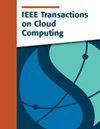基于 DRL 的无线供电和无人机辅助反向散射 MEC 系统合同激励机制
IF 5.3
2区 计算机科学
Q1 COMPUTER SCIENCE, INFORMATION SYSTEMS
引用次数: 0
摘要
移动边缘计算(MEC)被认为是解决热点(HS)密集计算需求挑战的一项前景广阔的技术。在本文中,我们考虑了无人驾驶飞行器(UAV)辅助的反向散射 MEC 系统。无人飞行器可以从停机坪飞到热点地区,通过射频波束成形为热点地区提供能量,并通过反向散射收集热点地区无线用户的数据。我们的目标是在保证 HS 能量队列稳定的前提下,使所有 HS 的长期效用最大化。这个问题是数据卸载决策和合同设计的联合优化,应适应用户的随机任务需求和时变无线信道条件。本文提出了一种基于深度强化学习的合约激励(DRLCI)策略,分两步解决这一问题。首先,我们使用深度 Q 网络(DQN)算法,根据不断变化的网络环境更新 HS 的卸载决策。其次,为了激励无人机参与资源共享,我们设计了针对每种无人机的合同,并利用拉格朗日乘数法来接近最优合同。仿真结果表明了所提策略的可行性和效率,其性能优于自然 DQN 算法和双 DQN 算法。本文章由计算机程序翻译,如有差异,请以英文原文为准。
DRL-Based Contract Incentive for Wireless-Powered and UAV-Assisted Backscattering MEC System
Mobile edge computing (MEC) is viewed as a promising technology to address the challenges of intensive computing demands in hotspots (HSs). In this article, we consider a unmanned aerial vehicle (UAV)-assisted backscattering MEC system. The UAVs can fly from parking aprons to HSs, providing energy to HSs via RF beamforming and collecting data from wireless users in HSs through backscattering. We aim to maximize the long-term utility of all HSs, subject to the stability of the HSs’ energy queues. This problem is a joint optimization of the data offloading decision and contract design that should be adaptive to the users’ random task demands and the time-varying wireless channel conditions. A deep reinforcement learning based contract incentive (DRLCI) strategy is proposed to solve this problem in two steps. First, we use deep Q-network (DQN) algorithm to update the HSs’ offloading decisions according to the changing network environment. Second, to motivate the UAVs to participate in resource sharing, a contract specific to each type of UAVs has been designed, utilizing Lagrangian multiplier method to approach the optimal contract. Simulation results show the feasibility and efficiency of the proposed strategy, demonstrating a better performance than the natural DQN and Double-DQN algorithms.
求助全文
通过发布文献求助,成功后即可免费获取论文全文。
去求助
来源期刊

IEEE Transactions on Cloud Computing
Computer Science-Software
CiteScore
9.40
自引率
6.20%
发文量
167
期刊介绍:
The IEEE Transactions on Cloud Computing (TCC) is dedicated to the multidisciplinary field of cloud computing. It is committed to the publication of articles that present innovative research ideas, application results, and case studies in cloud computing, focusing on key technical issues related to theory, algorithms, systems, applications, and performance.
 求助内容:
求助内容: 应助结果提醒方式:
应助结果提醒方式:


